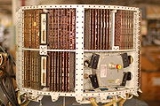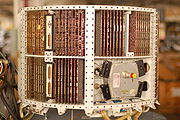
D-17B
Encyclopedia

Since an airborne, computer-controlled missile only gets one chance to execute its mission, the design specifications of the D-17B required very high reliability. This was achieved by using DRL (diode-resistor) logic
Diode logic
Diode logic or diode-resistor logic constructs Boolean logic gates from diodes acting as electrically operated switches. While diode logic has the advantage of simplicity, the lack of an amplifying stage in each gate limits its application...
extensively and only using DTL (diode-transistor) logic
Diode-transistor logic
Diode–transistor logic is a class of digital circuits that is the direct ancestor of transistor–transistor logic. It is called so because the logic gating function is performed by a diode network and the amplifying function is performed by a transistor .- Implementations :The DTL circuit shown in...
where gain or inversion was required in this fully solid-state computer. In the early 1960s when the D-17B was designed, transistors were not as reliable as they are now, thus the designers used transistors only when necessary. The
Specifications
Minuteman I D-17B Computer SpecificationsYear: 1962
The D17B is a synchronous serial general-purpose digital computer.
Manufacturer:
Autonetics Division of North American Aviation
Applications:
Guidance and control of the Minuteman I ICBM.
Programming and numerical system:
- Number system: Binary, fixed point, 2's complement
- Logic levels: 0 or False, OV; 1 or True, -10V
- Data word length (bits): 11 or 24 (double precision)
- Instruction word length (bits): 24
- Binary digits/word: 27
- Instructions/word: 1
- Instruction type: One and half address
Number of instructions: 39 types from a 4-bit op code by using five bits of the operand address field for instructions which do not access memory.
Execution times:
- Add (microseconds): 78 1/8
- Multiply (µs): 546 7/8 or 1,015 5/8 (double precision)
- Divide: (software)
(Note: Parallel processing such as two simultaneous single precision operations is permitted without additional execution time.)
Clock channel: 345.6 Hz
Addressing:
- Direct addressing of entire memory
- Two-address (unflagged) and three-address (flagged) instructions
Memory:
- Word length (bits): 24 plus 5 timing
- Type: Ferrous-oxide-coated NDRO disk
- Cycle time (µs): 78 1/8 (minimal)
- Capacity (words): 5,454 or 2,727 (double precision)
Input/output:
- Input lines: 48 digital
- Output lines: 28 digital
- 12 analog
- 3 pulse
- Program: 800 5-bit char/s
Instruction word format:
+--------+--------+------+--------+---------+--------+--------+
| TP | T24 21 | 20 | 19 13 | 12 8 | 7 1 | 0 |
+--------+--------+------+--------+---------+--------+--------+
| Timing | OP | Flag | Next | Channel | Sector | Timing |
| | | | Inst. | | | |
| | | | Sector | | | |
+--------+--------+------+--------+---------+--------+--------+
Registers:
- Phase and voltage output registers
Arithmetic unit (rxcluding storage access):
- Add: 78 µs
- Multiply: 1,016 µs
Construction (arithmetic unit only): transistor-diode logic is used.
- Timing: Synchronous
- Operation: Sequential
| Medium | No. of Words | Access (µs) | |||||||||||||||||||||
|---|---|---|---|---|---|---|---|---|---|---|---|---|---|---|---|---|---|---|---|---|---|---|---|
| Rotating disk | 2,688 | 5,000 avg. | (gen. purp. channels) | Rotating disk | 41 | (rapid access poops) | 40 | (1 word loop) | 160 | (4 word loop) | 320 | (8 word loop) | 640 | (16 word loop) |
Input
- 48 digital lines (input)
- 26 specialized incremental inputs
-Medium- -Speed-
Paper/Mylar Tape 600 chars/sec
Keyboard Manual
Typewriter Manual
OUTPUT
-Medium- -Speed-
Printer Character 78.5–2,433 ms (Program Control)
Phase - Voltage (Program Control)
28 digital lines (output)
12 analog lines (output)
13 pulse lines (output)
25,600 word/s maximum I/O transfer rate
Physical characteristics
- Dimensions: 20 in high, 29 in diameter, 5 in deep
- Power: 28 VDC at 25 A
- Circuits: DRL and DTL
- Weight: 62 pounds (28.1 kg)
Construction:
- Double copper clad, gold plated, glass fiber laminate, flexible polyurethanePolyurethaneA polyurethane is any polymer composed of a chain of organic units joined by carbamate links. Polyurethane polymers are formed through step-growth polymerization, by reacting a monomer with another monomer in the presence of a catalyst.Polyurethanes are...
-coated circuit boards
Software:
- Minimal delay coding using machine language
- Modular special-purpose subroutines
Reliability: 5.5 years MTBF
Checking features:
Parity on fill and on character outputs
Power, space, weight, and site preparation
- Power, computer: 0.25 kW
- Air conditioner: Closed system
- Volume, computer: 1.55 cu ft (43.9 l)
- Weight, computer: 70 lb (31.8 kg)
- Designed specifically to fit in cylindrical guidance package.
The word length for this computer Is 27 bits, of which 24 are used In computation. The remaining 3 bits are spare and synchronizing bits. The memory storage capability consists of a 6000 rpm magnetic disk with a storage capacity of 2985 words of which 2728 are addressable. The contents of memory include 20 cold-storage channels of 128 sectors (words) each, a hot-storage channel of 128 sectors, four rapid access loops (U,F,E,H) of 1, 4, 8, and 16 words respectively, four 1-word arithmetic loops (A, L,H,I), and a two 4-word input buffer input loops (V,R).
The outputs that can be realized from the D-17B computer are binary, discrete, single character, phase register status, telemetry, and voltage outputs. Binary outputs are computer generated levels of +1 or −1 available on the binary output lines.
Instruction set
D-17B Instruction Repertoire
Numeric Code Code Description
------------ ---- -----------
00 20, s SAL Split accumulator left shift
00 22, s ALS Accumulator left shift
00 24, 2 SLL Split left word left shift
00 26, r SLR Split left word right shift
00 30, s SAR Split accumulator right shift
00 32, s ARS Accumulator right shift
00 34, s SRL Split right word left shift
00 36, s SRR Split right word right shift
00 60, s COA Character output A
04 c, S SCL Split Compare and .ivt
10 c, S TMI Transfer on minus
20 c, s SMP Split multiply
24 c, s MPY Multiply
30 c, s SMM Split multiply modified
34 c, s MPM Multiply modified
40 02, s BOC Binary output C
40 10, s BCA Binary output A
40 12, s BOB Binary output B
40 20, s RSD Reset detector
40 22, s HPR Halt and Proceed
40 26, s DOA Discrete output A
40 30, s VOA Voltage output A
40 32, s VOB Voltage output B
40 34, s VOC Voltage output C
40 40, s ANA And to accumulator
40 44, s MIM Minus magnitude
40 46, s COM Complement
40 50, s DIB Discrete input B
40 52, s DIA Discrete input A
40 60, s HFC Halt fine countdown
40 70, s LPR Load phase register
44 c, s CIA Clear and Add
50 c, s TRA Transfer
54 c, s STO Store accumulator
60 c, s SAD Split add
64 c, s ADD Add
70 c, s SSU Split subtract
74 c, s SUB Subtract

Guidance software
AutoneticsAutonetics
Autonetics was a division of North American Aviation. Through a series of mergers, Autonetics is now part of Boeing.- General Background of the Anaheim Facility :...
was the associate contractor for the Minuteman (MM) guidance system, which included the flight and prelaunch software. This software was programmed in assembly language into a D17 disk computer. TRW
TRW
TRW Inc. was an American corporation involved in a variety of businesses, mainly aerospace, automotive, and credit reporting. It was a pioneer in multiple fields including electronic components, integrated circuits, computers, software and systems engineering. TRW built many spacecraft,...
provided the guidance equations that Autonetics programmed and was also responsible for the verification of the flight software. When MM I became operational, the flight computer was the only digital computer in the system. The targeting was done at Strategic Air Command (SAC) Headquarters by the Operational Targeting Program developed by TRW to execute on an IBM 709 mainframe computer.
Sylvania Electronics Systems was selected to develop the first ground-based command and control system using a programmable computer. They developed the software, the message processing and control unit for Wing 6. To support the deployment of the Wing 6 system, TRW, Inc. developed the execution plan program (EPP) from a mainframe computer at SAC and performed an independent checkout of the command and control software. The EPP assisted in assigning targets and launch time for the missiles.
The MM II missile was deployed with a D-37C
D-37C
The D-37C is the computer component of the all-inertial NS-17 Missile Guidance Set for accurately navigating to its target thousands of miles away. The NS-17 MGS was used in the Minuteman II ICBM...
disk computer. Autonetics also programmed functional simulators and the code inserter verifier that was used at Wing headquarters to generate and test the flight program codes to go into the airborne computer.

